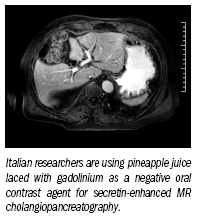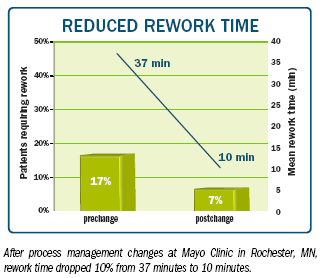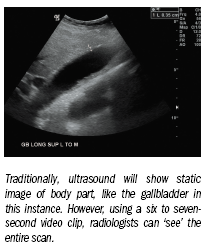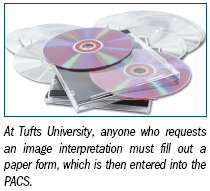Ten innovative strategies could improve your practice
In the quest for better use of patient histories, a team from the University of California, San Diego has devised a unique system that gives them access to the hospital information system on their PACS.
OPEN-SOURCE SOFTWARE PROVIDES READY ACCESS TO PATIENT HISTORIES
In the quest for better use of patient histories, a team from the University of California, San Diego has devised a unique system that gives them access to the hospital information system on their PACS. They are using an open-source software program, Autohotkey, to synchronize the PACS and the HIS, allowing them to open up patient records for a more thorough understanding of the imaging studies they review.
The system allows them to automate any program by sending keystrokes and mouse clicks, according to the macro's creator, Dr. Amilcare Gentili, a clinical radiology professor at UCSD. It is also possible to write a macro and compile it into a small executable file that can be run from any directory, without any need for installation or registry modification.
The macro can be found on Gentili's website at http://gentili.net. The sole caveats are that the macro works only for the Windows platform and that it was tested only with Agfa Impax 5.2 and CPRS, according to Gentili.
Most residents and fellows at UCSD are using the open-source software if their workstations are connected to both the PACS and the HIS.
"It speeds up checking the clinical history and increases the number of times that the clinical history is reviewed. In a few cases, knowing the clinical history has changed the interpretation of the images," Gentili said.
STUDY PINPOINTS KEYS TO VOICE RECOGNITION SUCCESS
Radiology facilities have struggled with the adoption of voice recognition technology. It should have been yielding big improvements in efficiency, but, too often, the results have been less than expected.
A study conducted at the University of North Carolina, in its 700-bed academic hospital, found that the issues were less technological than human. The amount of time and energy a radiologist or radiology team is willing to devote to learning the new system is one key factor.
The study used report turnaround times before and after the adoption of voice recognition as the benchmark for improvement. Results among the facility's 30 radiologists varied widely. Reductions in turnaround time ranged from 93% to –33%, with two radiologists actually extending their report turnaround times under voice recognition.
One of the researchers, Dr. Arun Krishnaraj, summarized the main problems in the adoption of voice recognition by tapping radiologists who:
• did not invest time to refine the voice recognition vocabulary for better speech recognition;
• did not contact and work with IT support to learn more about the workflow improvements afforded by voice recognition;
• frequently reverted back to the legacy system when frustrated by the voice recognition system;<
• did not use the voice recognition system interface to finalize reports; and
• lacked patience.
"Any new technology will take some time getting used to," Krishnaraj said. "Those with less patience in learning how to alter their workflow to benefit from voice recognition fared worse than those who initially were slowed by the system but persevered."
PINEAPPLE CONTRAST PLEASES PATIENTS AND SAVES MONEY, TOO
Researchers from Italy are saving money and delighting patients by using pineapple juice laced with gadolinium as a negative oral contrast agent for secretin-enhanced MR cholangiopancreatography.
Between May 2007 and May 2008, 100 consecutive patients referred for secretin-enhanced MR cholangiopancreatography were examined after ingestion of 180 mL of ferumoxsil or 180 mL of pineapple juice labeled with 1 mL of gadolinium.

Dr. Gennaro Restaino, a radiologist at the John Paul II Center for High Technology Research in Campobasso, and colleagues found that palatability scored much higher for the pineapple juice than for the ferumoxsil. Signal cancellation in the stomach, duodenum, and jejunum and quality of visualization of the main pancreatic duct showed no significant differences between the two groups. While the overall quality of the exam was slightly higher with ferumoxsil, Restaino and colleagues have shifted to pineapple for contrast.
"We save around €40 ($53) per examination," he said.
FACILITY FINDS CT LUNG DATA STORAGE SHORTCUT
With 64-slice scanners rapidly becoming the norm, finding ways to store an escalating volume of CT data is a challenge for many facilities. Research at a university hospital in Victoria, BC, found that you can reduce your data storage needs by reading CT lung scans at 3 mm per slice and storing reconstructed images needed for follow-up at 10 mm.
In a survey of scans from 58 patients, researchers at Queen's University identified 153 noncalcified nodules in 3-mm-thick CT slices stored as digital data and compared them with reconstructed 10-mm-thick slices archived on film. Only two nodules, one 2.3 mm and the other 2.5 mm in diameter, were not seen on the reconstructed images.
The archive savings from storing 10-mm images could be considerable. An average CT chest study with 200 3-mm-thick images occupies approximately 52 MB of space, the researchers said. Shifting to 10-mm storage could reduce that amount by 60%.
Despite the success of the research, Queen's University has not made the approach its standard protocol. The facility is waiting for other studies to confirm the findings, Hong said.
POPULAR GAMING DEVICE MAY OFFER BETTER WAY TO NAVIGATE IMAGES
It may be a ways into the future, but researchers at New York City hospitals say there's a good possibility the popular Wii gaming remote could one day replace the dreaded mouse and keyboard as a way to navigate digital images.

Their study was conducted at the New York-Presbyterian Hospital/Weill Cornell Medical Center, and, at this point, it offers more proof of concept than actual clinical experience. Still, it does point the way to a more sophisticated and, perhaps, less injurious approach to image manipulation, said Drs. Cliff Yeh, Matthew Amans, and George Shih, lead authors of the study.
All the basic features that a radiologist routinely requires can be performed using the handheld device. Key to the approach was the use of infrared technology. The infrared handheld device with motion sensing capability allowed the user to scroll/pan/window/zoom through a set of images via hand movements and pointing.
With numbers of studies and data sets per study both growing, the alternative user interface offers the potential to interact with image studies more intuitively, the researchers said. The technology may also alleviate the ergonomic health concerns associated with the traditional keyboard-mouse user interface, particularly as radiologists tackle more complex 3D image data sets.
NEW DIAGNOSTIC MAMMOGRAPHY PROCESS BOOSTS PATIENT, STAFF SATISFACTION
Small process changes can yield big results. A study at the Mayo Clinic in Rochester, MN, analyzed diagnostic mammography processes and made minor adjustments that cut redo exams and patient exam times while improving patient and staff satisfaction.
Even small changes can make a significant difference, said lead author Dr. Jeremy Friese of the radiology department.
The Mayo researchers found that it took 72 minutes to collect and interpret a diagnostic mammogram. At the suggestion of a quality advisor, a technologist and a radiologist conducted the entire study on a patient from planning to interpretation. The other change was having imaging parameters given the same day as the diagnostic mammogram rather than at the time of screening mammography.
After the changes, Friese and colleagues found the need to redo exams dropped from 17% to 7% for radiologists and from 32% to 20% for technologists. Time in the department fell from 54 minutes to 38 minutes due to consolidation and elimination of process steps. Patient satisfaction regarding wait time rose from 87% to 96%, and employee satisfaction improved from 2.95 stars out of five to 4.19.
Process improvement has also been used in interventional radiology, nuclear medicine, and CT, according to Friese. He credits the success of the changes to having a multidisciplinary group with time to examine, test changes, and reexamine the problem.
CINE CLIPS IMPROVE ACCURACY OF ULTRASOUND DIAGNOSES
Though the quest to save time is constant, when it comes to ultrasound exams, Arkansas researchers have succeeded. They found cine clips not only save time but facilitate better communication between sonologists and clinicians.
"Cine clips make the ultrasound examination faster because the sonographer obtains a cine sweep through an entire organ instead of trying to obtain static images," said Dr. Ashley Bragg, a radiology resident at the University of Arkansas for Medical Sciences in Little Rock.
The radiologist can see the entire scan, so fewer
repeat examinations are required. Plus, the radiologist takes less time scanning because he or she feels more comfortable and confident with the cine clips as opposed to static images.
Bragg and colleagues compared scan times before and after the introduction of the six to seven-second cine clips. Once the staff started using the clips, scan times dropped from 6.5 minutes to 3.4 minutes for neonatal heads, 16.3 minutes to 13.07 minutes for a complete abdomen, and 24.06 minutes to 11.8 minutes for pelvic exams.
Though cine clips require more storage than static images, the requirements are on par with a routine CT scan, Bragg said. Some PACS, however, may require upgrades to become compatible with the clips.
"When cine clips are used, it is as if the radiologist is in the room scanning with the sonographer," Bragg said.
DUAL-PHASE SCAN YIELDS DIAGNOSTIC BONUS FOR CT OF PULMONARY EMBOLI
Indirect CT phlebography can serve as a one-stop shop for simultaneously diagnosing pulmonary emboli and peripheral vascular thrombosis. CT phlebography first scans the chest and then the lower leg veins, where nine of 10 emboli originate.
The procedure takes advantage of a single bolus of contrast, which is used to interrogate the heart and lungs and then flows to the deep venous system a few seconds later to help diagnose thrombosis. Early diagnosis of deep vein thrombosis can speed its treatment, and indirect CT phlebography reduces the need for more imaging procedures, said Dr. Joachim E. Wildberger, chair of radiology at Maastricht University Medical Center in the Netherlands, during a presentation at the 2009 International Symposium on Multidetector-Row CT in May.

But indirect CT phlebography is not for everyone with suspected PE. Adding the lower extremity vein scan exposes patients to about 9 mSv of radiation. The dose exposure can be controlled by limiting the peripheral vascular evaluation to patients with known PE and deciding whether to scan the lower legs based on the presence of emboli in the lungs and heart.
The Maastricht group reported good results with 161 patients with suspected PE; the thoracic exam helped diagnose 62 positive cases. Indirect CT phlebography led to the detection of DVT among 47 patients. The DVT yield for 99 patients with no PE, however, was 5.1%.
"We target high-risk patients," Wildberger said. "These are people who have a history of pulmonary embolism, who have malignant disease, who suffer from cardiovascular disease, or who have undergone surgery in the four weeks before imaging takes place."
PAPER REQUISITIONS CAN SOLVE CURBSIDE CD CONSULT PROBLEM
Radiologists struggling with how to manage "curbside" consults drawn from those now-ubiquitous CDs may find relief in a surprising quarter: paper-based requisition forms.
The system was developed at Tufts University after radiologists found they were reading the same CD-based study again and again and, worse, not getting paid for it, said Dr. Jeffrey B. Mendel, chair of radiology.

Their solution: a paper-based requisition form presented to any party that requests an interpretation of an image on the CD. Information from the requisition is then entered into the PACS, usually with a preliminary interpretation. The requisition also allows follow-up questions and billing of the interpretation.
The form covers patient and referring clinician information, patient history, reasons for the study, previous discussions of the case, and routing options for the CD after the image has been captured. It also alerts the referring clinician that the interpretation is billable.
The forms are widely available, and multiple people are trained to process the studies from the CDs. The facility has found that most of the patients are already in the PACS, but, if not, the staff can call the referring clinician and get the information.
But if there's no existing patient record in PACS, how can the radiologist avoid having to re-review the images when the report is dictated? Most make a handwritten note on the referral form, which is scanned into the PACS and available when it's time to dictate the findings, Mendel said.
GETTING CT COLONOGRAPHY RIGHT MEANS GETTING THE RIGHT TRAINING
Training trumps experience when it comes to interpreting CT colonography, according to Dr. Abe Dachman, director of the Fellowship Programs at the University of Chicago Medical Center.
Hands-on training with at least 75 cases is needed to catch and properly characterize polyps visualized with CTC, Dachman said. Differentiating experience with these cases from routine practice, where physicians simply learn by doing, is the feedback trainees get when they make errors. Dachman, a nationally known authority on virtual colonoscopy, calls this feedback "an unblinding to the truth."
"You have to be able to learn from your mistakes," he said.
Citing evidence from his and others' research, Dachman argues that proper training is critical to achieving high sensitivity and specificity on CTC exams. This is so because of the difficulty interpreters have when trying to characterize lesions of the colon.
"It's not just finding the polyp," he said. "About half the errors are errors of characterization. The good news is that with more training, (even those who have been making errors) can learn to do a good job."
Hands-on work is one of two critical elements of a comprehensive training program for CTC. The other is composed of lectures that explain how to integrate this examination into clinical practice. Patient preparation strategies, exam performance, and aspects of making interpretations such as the principles and pitfalls of software must also be included, as well as an understanding of extracolonic findings and ongoing developments in the field.
Training of this kind is readily available in courses and workshops offered by professional associations. Online teaching and testing are also available from such places as the Virtual Colonoscopy Teaching Centre.
With reporting from John C. Hayes, James Brice, Greg Freiherr, and Rebekah Moan.
GE HealthCare Debuts AI-Powered Cardiac CT Device at ACC Conference
April 1st 2025Featuring enhanced low-dose image quality with motion-free images, the Revolution Vibe CT system reportedly facilitates improved diagnostic clarity for patients with conditions ranging from in-stent restenosis to atrial fibrillation.
The Reading Room Podcast: Current Perspectives on the Updated Appropriate Use Criteria for Brain PET
March 18th 2025In a new podcast, Satoshi Minoshima, M.D., Ph.D., and James Williams, Ph.D., share their insights on the recently updated appropriate use criteria for amyloid PET and tau PET in patients with mild cognitive impairment.